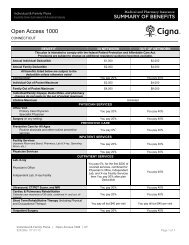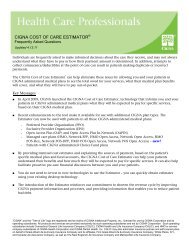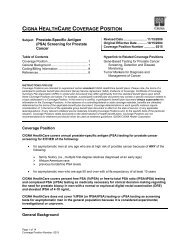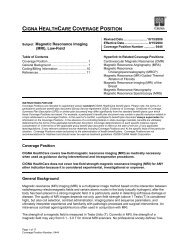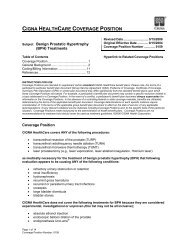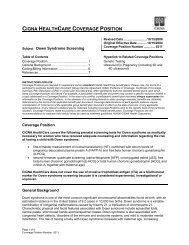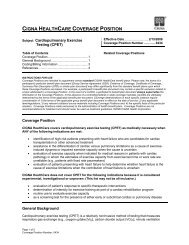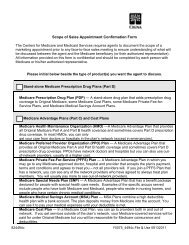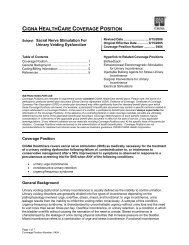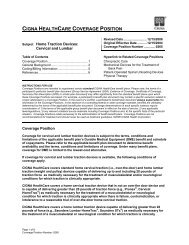Cranial Orthotic Devices for Positional or Deformational Plagiocephaly
Cranial Orthotic Devices for Positional or Deformational Plagiocephaly
Cranial Orthotic Devices for Positional or Deformational Plagiocephaly
- No tags were found...
You also want an ePaper? Increase the reach of your titles
YUMPU automatically turns print PDFs into web optimized ePapers that Google loves.
Table 1Cephalic IndexGender Age - 2 SD - 1SD Mean + 1SD + 2SDMale 16 days – 6 months 63.7 68.7 73.7 78.7 83.76-12 months 64.8 71.4 78.0 84.6 91.2Female 16 days – 6 months 63.9 68.6 73.3 78.0 82.76-12 months 69.5 74.0 78.5 83.0 87.5The evaluation of cranial asymmetry may also be made based on one <strong>or</strong> m<strong>or</strong>e of three anthropometricmeasures: cranial vault, skull base <strong>or</strong> <strong>or</strong>bitotragial depth measurements. Table 2 below defines how thesemeasurements are taken. A physician <strong>or</strong> technician skilled in anthropometry should per<strong>f<strong>or</strong></strong>m allanthropometric measurements (Littlefield, et al., 1998).AnthropometricMeasure<strong>Cranial</strong> VaultSkull BaseOrbitotragial DepthTable 2Specifications <strong>f<strong>or</strong></strong> Taking Anthropometric MeasurementsMeasurement[left frontozygomatic point (fz) to right euryon (eu)] minus[right frontozygomatic point (fz) to left euryon (eu)][subnasal point (sn) to left tragus (t)] minus [subnasal point(sn) to right tragus (t)][left exocanthion point (ex) to left tragus (t)] minus [rightexocanthion point (ex) to right tragus (t)]Treatment <strong>f<strong>or</strong></strong> <strong>Positional</strong> <strong>Plagiocephaly</strong>Treatment <strong>f<strong>or</strong></strong> positional plagiocephaly is based on the age of the infant and the severity of the de<strong>f<strong>or</strong></strong>mity.The optimal treatment is prevention through active counterpositioning of sleeping babies until they areable to move their heads freely during sleep, usually by six months of age. Primary treatment <strong>f<strong>or</strong></strong>positional plagiocephaly in infants under age six months is a trial of physical and positional therapy(Marshall, et al., 1997). This treatment generally lasts 2-3 months to encourage n<strong>or</strong>mal neck mobility andto discourage continued pressure on the affected area (Pollack, et al., 1997).Infants <strong>f<strong>or</strong></strong> whom physical and positional therapy have failed <strong>or</strong> who are six months <strong>or</strong> older when thediagnosis of positional plagiocephaly is made may require active reshaping of the skull through anexternal <strong>or</strong>thosis. The cranial <strong>or</strong>thosis is a molded helmet used to redirect growth of the skull bones anddecrease cranial asymmetry. The best response to use of the helmet occurs at 6-12 months of agebecause of the greater malleability of infant skull bone and the n<strong>or</strong>malizing effect of the rapid growth ofinfant brain tissue. When the cranial helmet is used after 12 months of age, there is less improvement inthe shape of the cranial structure. Surgery <strong>f<strong>or</strong></strong> c<strong>or</strong>rection of positional plagiocephaly is rarely warranted(Marshall, et al., 1997; Pollack, et al., 1998).<strong>Cranial</strong> <strong>or</strong>thotic devices have been shown to be effective in attaining (Littlefield, et al., 1998; Loveday, etal., 2001; Moss, 1997; Pollack, et al., 1997) and maintaining (Littlefield, et al., 1997) a m<strong>or</strong>e n<strong>or</strong>mal headshape in infants with positional plagiocephaly. These devices may be dynamic, compressing theprominent part of the skull, <strong>or</strong> passive, allowing growth only in the flattened part of the skull. They aregenerally w<strong>or</strong>n 15-22 hours a day, and length of treatment depends on the infant's age, the severity of theasymmetry, and compliance with the treatment regimen (Littlefield, et al., 1998; Loveday, et al., 2001;Pollack, et al., 1997). Treatment is most effective when begun during the first year of life, when braingrowth is most rapid (Kelly, et al., 1999; Loveday, et al., 2001; Marshall, et al., 1997; Pollack, et al.,1997). In some cases, where rapid growth and c<strong>or</strong>rection make it necessary, a second band may berequired (<strong>Cranial</strong> Technologies, Phoenix, AZ). Replacement would depend on individual growth patterns.Page 3 of 8Coverage Position Number: 0056
There is little clarity <strong>or</strong> agreement in the research literature as to the criteria <strong>f<strong>or</strong></strong> initiating cranial <strong>or</strong>thotictherapy. Wood (2000) suggests that, since slight variations in head shape and size are consideredn<strong>or</strong>mal, the use of cranial <strong>or</strong>thoses should be selective and is indicated only when failure to treat wouldleave the child with an enduring abn<strong>or</strong>mal appearance. Several researchers have attempted to quantifythe level of asymmetry <strong>f<strong>or</strong></strong> which treatment with <strong>or</strong>thotic devices would be appropriate. Loveday et al.(2001) used as criteria <strong>f<strong>or</strong></strong> treatment a cranial index that represents the head’s width as a percent of itslength. Moss (1997) treated infants with moderate to severe plagiocephaly, defined as an asymmetry of12 mm <strong>or</strong> m<strong>or</strong>e, with molding bands. Mulliken and associates (1998) describe maj<strong>or</strong> cranial asymmetry asa difference of 10-12 mm. Several studies (Kelly, et al., 1999; Littlefield, et al., 1998; Marshall, et al.,1997; Pollack, et al., 1997) do not offer quantified criteria <strong>f<strong>or</strong></strong> initiation of treatment with a cranial <strong>or</strong>thosis.The long-term effects of unresolved positional plagiocephaly are unclear. In an analysis of the peerreviewedliterature, Rekake (1997) found little to suggest any long-term visual, jaw <strong>or</strong> cognitive problemsrelated to non-synostotic plagiocephaly. Auth<strong>or</strong>s have rep<strong>or</strong>ted that infants with positional plagiocephalyare at risk <strong>f<strong>or</strong></strong> developmental difficulties during the school-age years, although they found no differencebetween children who were treated with helmets and those who were not (Miller and Clarren, 2000).Panchal et al (2001) rep<strong>or</strong>ted that be<strong>f<strong>or</strong></strong>e any intervention (i.e. molding helmet therapy), infants with singlesuture syndromic craniosynostosis and plagiocephaly without synostosis demonstrated delays incognitive and psychomot<strong>or</strong> development when compared with a standardized population sample. Panchalet al. (2001) did not rep<strong>or</strong>t on post interventional outcomes, thus, this study could not evaluate efficacy ofmolding helmet therapy. Strabismus has been rep<strong>or</strong>ted in synostotic plagiocephaly; however, there is noevidence that it occurs in positional plagiocephaly (Bridges, et al., 2000).The U.S. Food and Drug Administration (FDA) approved the Dynamic <strong>Orthotic</strong> Cranioplasty (DOC ) band(<strong>Cranial</strong> Technologies, Inc., Phoenix, AZ) in 1999. Since then, several companies have received 510(k)approval to manufacture the cranial <strong>or</strong>thotic device. To receive 510(k) approval, the device is consideredsubstantially equivalent to another device already on the market. The manufacturer is not required tosupply to the FDA evidence of the effectiveness of its cranial <strong>or</strong>thotic pri<strong>or</strong> to marketing the device. FDAapproved<strong>or</strong>thoses and their manufacturers include:• Dynamic <strong>Orthotic</strong> Cranioplasty (DOC ) Band, <strong>Cranial</strong> Technologies, Inc. (Phoenix, AZ)• Ballert <strong>Cranial</strong> Molding Helmet, Ballert Orthopedic (Chicago, IL)• RHS <strong>Cranial</strong> Helmet, Rest<strong>or</strong>ative Health Services, Inc. (Nashville, TN)• <strong>Cranial</strong> Shaping Helmet, Lone Star <strong>Orthotic</strong>s, Inc. (Houston, TX)• Hanger <strong>Cranial</strong> Band, Hanger Orthopedic Group, Inc. (Bethesda, MD)• P.A.P. Orthosis (Plagiocephalic Applied Pressure Orthosis), Personal Per<strong>f<strong>or</strong></strong>mance Medical C<strong>or</strong>p.• Static Cranioplasty Orthosis, Luke Stikeleather Co. (Fairfax, VA)• O & P <strong>Cranial</strong> Molding Helmet, <strong>Orthotic</strong> and Prosthetic Lab, Inc. (Evansville, IN)• <strong>Cranial</strong> Solutions Orthosis CSO, <strong>Cranial</strong> Solutions (Pompton Lakes, NJ)• <strong>Cranial</strong> Symmetry System, Beverly Hills Prosthetics <strong>Orthotic</strong>s, Inc. (Los Angeles, CA)• STARband , STARlight <strong>Cranial</strong> Remolding Orthosis, and the Clarren Helmet, OrthomericaProducts, Inc. (Newp<strong>or</strong>t Beach, CA)• ECA <strong>or</strong>thosis, Eastern <strong>Cranial</strong> Affiliates (Arlington, VA)• COPC Band, Center <strong>f<strong>or</strong></strong> <strong>Orthotic</strong> and Prosthetic Care of KY (Louisville, KY)• cranial <strong>or</strong>thoses manufactured by:ooChildren’s Health Care Services, Fountain Valley Prosthetics and <strong>Orthotic</strong>s Inc. (FountainValley, CA)Precision Prosthetics & <strong>Orthotic</strong>s (St Louis, MO)Acc<strong>or</strong>ding to the FDA, cranial <strong>or</strong>thoses are Class II medical devices intended "<strong>f<strong>or</strong></strong> medical purposes toapply pressure to prominent regions of an infant's cranium in <strong>or</strong>der to improve cranial symmetry and/<strong>or</strong>shape in infants from 3 to 18 months of age, with moderate to severe nonsynostotic positionalplagiocephaly.” Acc<strong>or</strong>ding to the CranioCap (Gillette Children's, St. Paul, MN) FDA product insert, thedevice is contraindicated <strong>f<strong>or</strong></strong> use with infants with synostosis <strong>or</strong> hydrocephalus. Head circumferencemeasurements and neurological status must be assessed at intervals appropriate to the infant's age, andPage 4 of 8Coverage Position Number: 0056
skin integrity should be assessed every 3-4 hours to avoid skin irritation and breakdown. There havebeen no studies directly comparing the different types of <strong>or</strong>thotic devices.Patient Selection<strong>Cranial</strong> <strong>or</strong>thotic devices are contraindicated in infants and children with untreated hydrocephalus <strong>or</strong>untreated craniosynostosis. <strong>Cranial</strong> <strong>or</strong>thotic devices may be used following surgical c<strong>or</strong>rection ofcraniosynostosis <strong>or</strong> in infants with excess bossing secondary to sagittal synostosis (Mulliken, et al., 1999).Summary<strong>Positional</strong> <strong>or</strong> de<strong>f<strong>or</strong></strong>mational plagiocephaly is considered to be a relatively benign condition resulting fromexternal pressure that causes the skull to be misshapen. Although recently some auth<strong>or</strong>s have suggestedthere might be a c<strong>or</strong>relation between de<strong>f<strong>or</strong></strong>mational plagiocephaly and neurodevelopmental dis<strong>or</strong>ders, theinterpretation of preliminary data is not clear at present and further studies are warranted. Treatment <strong>f<strong>or</strong></strong>moderate to severe positional plagiocephaly may consist of repositioning therapy, cranial helmet and/<strong>or</strong>surgery, although surgery is rarely warranted. When repositioning therapy has been unsuccessful <strong>f<strong>or</strong></strong>moderate to severe plagiocephaly, cranial <strong>or</strong>thotic devices are generally utilized. These devices aredesigned to mold the infant’s skull back into the c<strong>or</strong>rect position and have been found in the published,peer-reviewed, scientific literature to be safe and effective <strong>f<strong>or</strong></strong> reducing skull asymmetry.Coding/Billing In<strong>f<strong>or</strong></strong>mationNote: This list of codes may not be all-inclusive.Covered when medically necessary:CPT ® *CodesHCPCSCodesL0100L0110S1040DescriptionNo specific codesDescription<strong>Cranial</strong> <strong>or</strong>thosis (helmet) with <strong>or</strong> without soft interface, molded to patient model<strong>Cranial</strong> <strong>or</strong>thosis (helmet) with <strong>or</strong> without soft interface, non-molded<strong>Cranial</strong> remolding <strong>or</strong>thosis, rigid with soft interface material, custom fabricated,includes fitting and adjustmentsICD-9-CM DescriptionDiagnosisCodes754.0 Congenital Musculoskeletal de<strong>f<strong>or</strong></strong>mity of skull, face and jaw756.0 Anomalies of skull and face bonesV48.6 Disfigurements of head*Current Procedural Terminology (CPT ® ) © 2005 American Medical Association: Chicago, IL.References1. Biggs WS. Diagnosis and management of positional head de<strong>f<strong>or</strong></strong>mity. Am Fam Physician. 2003May;67(9):1953-6.Page 5 of 8Coverage Position Number: 0056
2. Bridges SJ, Chamber TL, Pople IK. <strong>Plagiocephaly</strong> and head binding. Arch Dis Child. 2002Mar;86(3):144-5.3. Bruner TW, David LR, Gage HD, Argenta LC. Objective outcome analysis of soft shell helmettherapy in the treatment of de<strong>f<strong>or</strong></strong>mational plagiocephaly. J Craniofac Surg. 2004 Jul;15(4):643-50.4. Code of Federal Regulations. <strong>Cranial</strong> <strong>or</strong>thosis. Title 21, Vol. 8, Sec. 882.5970. Accessed January24, 2006. Available at URL address:http://www.accessdata.fda.gov/scripts/cdrh/cfdocs/cfcfr/CFRSearch.cfm?fr=882.5970&SearchTerm=cranial%20<strong>or</strong>thosis5. Collett B, Breiger D, King D, Cunningham M, Speltz M. Neurodevelopmental implications of“de<strong>f<strong>or</strong></strong>mational” plagiocephaly. J Dev Behav Pediatr. 2005 Oct;26(5):379-89.6. <strong>Cranial</strong> Technologies. DOC ® : Dynamic <strong>Orthotic</strong> Cranioplasty SM [online brochure]. AccessedJanuary 24, 2006. Available at URL address:http://www.cranialtech.com/parentsarea/publications/brochure.pdf7. Farkas LG, Munro IR, edit<strong>or</strong>s. Anthropometric facial prop<strong>or</strong>tions in medicine. Springfield, IL:Charles C. Thomas; 1987.8. Graham JM, Gomez M, Halberg A, Earl DL, Kreutzman JT, Cui J, Guo X. Management ofde<strong>f<strong>or</strong></strong>mational plagiocephaly: repositioning versus <strong>or</strong>thotic therapy. J Pediatr. 2005Jan;146(2):258-62.9. HAYES Medical Technology Direct<strong>or</strong>y . <strong>Cranial</strong> <strong>Orthotic</strong> <strong>Devices</strong>. Lansdale, PA: HAYES, Inc.;© 2004 Winifred S. Hayes, Inc. Updated May 15, 2005.10. Institute <strong>f<strong>or</strong></strong> Clinical Systems Improvement (ICSI). <strong>Cranial</strong> <strong>or</strong>thoses <strong>f<strong>or</strong></strong> de<strong>f<strong>or</strong></strong>mationalplagiocephaly. ICSI Technology assessment rep<strong>or</strong>t. Approved March 2004. Accessed January25, 2006. Available at URL Address:http://www.icsi.<strong>or</strong>g/knowledge/detail.asp?catID=107&itemID=149511. Kabbani H, Raghuveer TS. Craniosynostosis. Am Fam Physician. 2004 Jun;69(12):2863-70.12. Kane AA, Mitchell LE, Craven KP, Marsh JL. Observations on a recent increase in plagiocephalywithout synostosis. Pediatrics. 1996 Jun;97(6 Pt. 1):877-85.13. Kelly KM, Littlefield TR, Pomatto JK, Ripley CE, Beals SP, Joganic EF. Imp<strong>or</strong>tance of earlyrecognition and treatment of de<strong>f<strong>or</strong></strong>mational plagiocephaly with <strong>or</strong>thotic cranioplasty. Cleft PalateCraniofac J. 1999 Mar;36(2):127-30.14. Kolar JC, Salter EM. Craniofacial anthropometry: practical measurement of the head and face <strong>f<strong>or</strong></strong>clinical, surgical and research use. Springfield, IL: Charles C. Thomas; 1997.15. Littlefield TR, Beals SP, Manwaring KH, Pomatto JK, Joganic EF, Golden KA, Ripley CE.Treatment of craniofacial asymmetry with dynamic <strong>or</strong>thotic cranioplasty. J Craniofac Surg. 1998Jan; 9(1):11-7.16. Littlefield TR, Pomatto JK, Beals SP, Manwaring KH, Joganic EF, Ripley CE. Efficacy andstability of Dynamic <strong>Orthotic</strong> Cranioplasty : an eight year investigation. Proceedings of the 7 thInternational Congress of the International Society of Craniofacial Surgery; 1997; Santa Fe, NM.p. 109-11.17. Losee JE, Mason AC. De<strong>f<strong>or</strong></strong>mational plagiocephaly: diagnosis, prevention, and treatment. ClinPlast Surg. 2005 Jan;32(1):53-64, viii.Page 6 of 8Coverage Position Number: 0056
18. Loveday B, de Chalain TB. Active counterpositioning <strong>or</strong> <strong>or</strong>thotic device to treat positionalplagiocephaly? J Craniofac Surg. 2001 Jul;12(4):308-13.19. Marshall D, Fenner GC, Wolfe A, M<strong>or</strong>rison G. Abn<strong>or</strong>mal head shape in infants. InternationalPediatrics: The Journal of Miami Children’s Hospital. 1997;12(3):172-7.20. Miller RE, Clarren SK. Long-term developmental outcomes in patients with de<strong>f<strong>or</strong></strong>mationalplagiocephaly. Pediatrics. 2000 Feb;105(2):e26.21. Moss SD. Nonsurgical, non<strong>or</strong>thotic treatment of occipital plagiocephaly: what is the natural hist<strong>or</strong>yof the misshapen neonatal head? J Neurosurg. 1997 Feb;87(5):667-70.22. Mulliken JB, Woude DLV, Hansen M, LaBrie RA, Michael SR. Analysis of posteri<strong>or</strong> plagiocephaly:de<strong>f<strong>or</strong></strong>mational versus synostotic. Plast Reconstr Surg. 1999 Feb;103(2):371-80.23. Panchal J, Amirsheybani H, Gurwitch R, Cook V, Francel P, Neas B, wt al. Neurodevelopment inchildren with single-suture craniosynostosis and plagiocephaly without synostosis. Plast ReconstrSurg. 2001 Nov;108(6):1492-8;discussion 1499-500.24. Persing J, James H, Swanson J, Kattwinkel J. Prevention and management of positional skullde<strong>f<strong>or</strong></strong>mities in infants. American Academy of Pediatrics Committee on Practice and Ambulat<strong>or</strong>yMedicine, Section on Plastic Surgery and Section on Neurological Surgery. Pediatrics. 2003Jul;112(1 Pt 1):199-202.25. Pollack IF, Losken HW, Fasick P. Diagnosis and management of posteri<strong>or</strong> plagiocephaly.Pediatrics. 1997 Feb;99(2):180-5.26. Rekake HL. Occipital plagiocephaly: a critical review of the literature. Neurosurg Focus. Acceptedin final <strong>f<strong>or</strong></strong>m 1997 Feb 4. © Copyright 2004 AANS. Accessed January 24, 2006. Available at URLaddress: http://www.aans.<strong>or</strong>g/education/journal/neurosurgical/feb97/2-2-1.asp27. Ridgeway EB, Weiner HL. Skull de<strong>f<strong>or</strong></strong>mities. Pediatr Clin N<strong>or</strong>th Am. 2004 Apr;51(2):359.28. Ripley CE, Pomatto J, Beals SP, Joganic EF, Manwaring KH, Moss SD. Treatment of positionalplagiocephaly with dynamic <strong>or</strong>thotic cranioplasty. J Craniofac Surg. 1994 Jul;5(4):150-9.29. U.S. Food and Drug Administration (FDA). Center <strong>f<strong>or</strong></strong> <strong>Devices</strong> and Radiological Health (CDRH).501(k) summary of effectiveness and safety: Lerman & Son <strong>Cranial</strong> Orthosis Helmet. 2001 Nov20. Accessed January 24, 2006. Available at URL address:http://www.fda.gov/cdrh/pdf/k012830.pdf30. U.S. Food and Drug Administration (FDA). Center <strong>f<strong>or</strong></strong> <strong>Devices</strong> and Radiological Health (CDRH).501(k) summary of effectiveness and safety: molded cranial helmet. 2001 Nov 28. AccessedJanuary 24, 2006. Available at URL address: http://www.fda.gov/cdrh/pdf/k012920.pdf31. U.S. Food and Drug Administration (FDA). Center <strong>f<strong>or</strong></strong> <strong>Devices</strong> and Radiological Health (CDRH).501(k) summary of effectiveness and safety: static cranioplasty <strong>or</strong>thosis. 2001 Apr 25. AccessedJanuary 24, 2006. Available at URL address: http://www.fda.gov/cdrh/pdf/k010273.pdf32. U.S. Food and Drug Administration (FDA). CranioCap . Product insert. Accessed online atGillette Children's Specialty Healthcare on January 24, 2006. Available at URL address:http://www.gillettechildrens.<strong>or</strong>g/default.cfm/pid=1.3.6.4.533. U.S. Food and Drug Administration (FDA). Medical devices; neurological devices; classification ofcranial <strong>or</strong>thosis. Federal Register. 1998 Jul 30;63(146):40650-2. Accessed January 24, 2006.Available at URL address: http://www.fda.gov/ohrms/dockets/98fr/073098b.txtPage 7 of 8Coverage Position Number: 0056
34. U.S. Food and Drug Administration (FDA). Center <strong>f<strong>or</strong></strong> <strong>Devices</strong> and Radiological Health (CDRH).Device listing database. ECA Orthosis. Accessed January 25, 2006. Available at URL Address:http://www.accessdata.fda.gov/scripts/cdrh/cfdocs/search/search.cfm?db=LST&ID=7664935. U.S. Food and Drug Administration (FDA). Center <strong>f<strong>or</strong></strong> <strong>Devices</strong> and Radiological Health (CDRH).501(k) summary of effectiveness and safety: COPC Band. November 13, 2003. AccessedJanuary 25, 2006. Available at URL address: http://www.fda.gov/cdrh/pdf2/k021594.pdf36. Wood RJ. De<strong>f<strong>or</strong></strong>mational plagiocephaly <strong>or</strong> misshapen head: integrated approach to diagnosis andtreatment essential to ruling out m<strong>or</strong>e serious conditions and obtaining optimal outcomes.Pediatric Perspective. 2000 Nov-Dec;9(6). Accessed online at Gillette Children's SpecialtyHealthcare on January 24, 2006. Available at URL address:http://www.gillettechildrens.<strong>or</strong>g/default.cfm/pid=1.7.8.1.9Page 8 of 8Coverage Position Number: 0056





